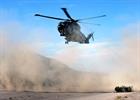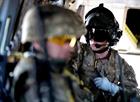Commandos’ desert eagles soar on two-month exercise in Californian heat
THE wings of the Royal Marines have completed two months of intensive training on one of the biggest mock battlegrounds in the world.
The Merlins of the Commando Helicopter Force stirred the dust of the Mojave desert, ferrying green berets, mortars and field guns by day and night into ‘battle’ in the largest live-firing exercise the Royal Marines have been involved in during 2015.
Exercise Black Alligator is held at the US Marine Corps’ vast ranges at Twenty-nine Palms inCalifornia, roughly half way betweenLas VegasandLos Angeles.
The area – roughly twice the size of Greater Manchester – allows ground troops and aircraft to let rip with live weapons as well as getting used to operating in a desert environment.
Supporting the 1,000 British, Dutch and US Marines on the ground were three Merlin Mk3 helicopters from 845 Naval Air Squadron, with more than 100 air and ground crew.
The helicopters were shipped from Marchwood near Southampton to Sunny Point inNorth Carolina.
From there, they faced a four-day journey of more than 2,000 miles across tenUSstates to reach Twenty nine Palms.
“The flight across the States proved a lot of work at times for us,” said Chief Petty Officer Stephen Stopforth, the senior engineer accompanying the detachment.
“We faced a few challenges we weren’t expecting – having to change an engine at the midway point was certainly one of them, although the help we received from the Mississippi Air National Guard was more than anyone could have asked for.”
The squadron, currently based at RAF Benson in Oxfordshire before it moves to the Commando Helicopter Force’s home at Royal Naval Air Station (RNAS) Yeovilton in Somerset, has only fairly recently switched from the veteran Sea King to the much newer Merlin.
Many personnel either had never operated in the desert before – or were out of touch with the dry, dusty, hot environment – outdoor temperatures were in the high 30s Celsius.
For the aircrews, that meant perfecting dust landings and operating the aircraft in the ‘hot and high’ conditions of the Mojave before moving on to more complicated training such as formation and night flying, and finally working with the men of 42 Commando.
Working with the marines from Bickleigh, nearPlymouth, offered a good variety of flying, ranging from troop insertions alongside RAF Chinooks, through to completing dummy drops to act as a diversion for mechanised companies rolling through the Mojave, and providing an airborne observation post for the commanders of each assault.
Black Alligator closed with a nine-day final ‘battle’ culminating with an assault on a 1,000-building mock town – with the Merlin squadron playing its full part.
The helicopters flew companies of Royal Marines into action as troops, artillery, mortars and main battle tanks moved in – all under the cover of darkness.
The helicopters were also expected to scramble at 30 minutes’ notice as ‘flying ambulances’ to collect simulated casualties.
“Having been on several tours flying in Afghanistan, and undertaking the training before we deployed, it’s amazing how well Twenty-nine Palms would prepare somebody for overseas operations,” said aircrewman Corporal Jay Whitehouse RM.
“Not only is the area far larger than anything we have in the UK, but the environment is perfect too. It was ideal for people who’ve not been to the desert before – and also for those who haven’t been for a while.”
Commander Matt Punch, 845’s Commanding Officer, said by the close of Black Alligator
“The men and women of my squadron were feeling “well worked up”. Overall, our deployment was a success – there was a vast amount of training carried out and experience gained for a squadron which was little more than a handful of weeks old when it deployed to the United States.”












